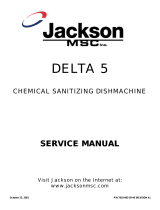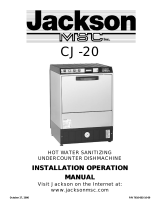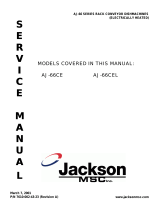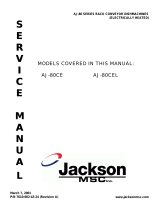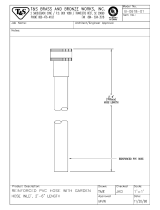Page is loading ...

TECHNICAL MANUAL
FOR JACKSON MODEL:
DELTA 5
Jackson MSC, INC.
P.O. BOX 1060
HWY. 25E
BARBOURVILLE, KY. 40906
FAX (606) 523-9196
PHONE (606) 523-9795
www.jacksonmsc.com
An
Company
CHEMICAL SANITIZING DISHMACHINE
August 3, 2004
P/N 7610-002-50-40 (Revision I)

This page is intentionally left blank.

i
REVISION
REVISION
DATE
MADE
BY
APPLICABLE
ECN
DETAILS
I 08-03-04 MAW 7051
Replaced 2 harnesses with new assembly. Converted to new lay-
out.

ii
NOMENCLATURE FOR THE MODELS COVERED IN THIS MANUAL:
DELTA 5
Chemical sanitizing undercounter dishmachine.
Model:
Serial No.:
Installation Date:
Service Rep. Name:
Phone No.:

iii
TABLE OF CONTENTS
SECTION DESCRIPTION PAGE
I. SPECIFICATION INFORMATION
Specifications 2
Dimensions 3
II. INSTALLATION/OPERATION INSTRUCTIONS
Installation Instructions 5
Electrical Power Connection 6
Operation Instructions 7
Programming Instructions 11
Programming Chart 13
III. PREVENTATIVE MAINTENANCE 14
IV. TROUBLESHOOTING SECTION
Troubleshooting Guide 17
Common Problems 18
VI. PARTS SECTION
Control Box Assembly 20
Ordering Replacement Wire 22
Ordering Replacement Conduit & Fittings 23
Control Box Cover Assembly 24
Chemical Feeder Pump Assembly 25
Electrical Connection Box Assembly 26
Frame Weldment/Hood Assembly 27
Tub Components 29
Spillway Weldment Assembly/Pump Suction Hose 30
Wash Arm Assembly 31
Upper Halo Assembly 32
Drain Solenoid/Drain Link Assembly 33
Booster Tank Assembly 34
Incoming Plumbing Assembly 35
Solenoid Valve Repair Parts 36
Pump and Motor Assembly 37
Motor and Pump Assembly (Exploded View of Parts) 38
Booster Tank Discharge Hose/Fill Tube Weldment Assembly 39
Strainers 40
Door Components 41
Front Panel Assembly 42
Side Panel Assemblies 45
8 Pin Harness 46
VII. Electrical Diagram (115 Volt, 60 Hz, Single Phase) 48

1
SECTION 1:
SPECIFICATION INFORMATION

2
SECTION 1: SPECIFICATION INFORMATION
DELTA 5 SPECIFICATIONS
OPERATING CAPACITY
RACKS PER HOUR 40
DISHES PER HOUR 1000
GLASSES PER HOUR 1000
OPERATING CYCLES (SECONDS)
NORMAL CYCLE
WASH TIME 45
RINSE TIME 25
TOTAL CYCLE TIME 90
HEAVY CYCLE
PREWASH TIME 20
WASH TIME 45
RINSE TIME 25
TOTAL CYCLE TIME 130
WASH TANK CAPACITY (GALLONS) 1.2
OPERATING TEMPERATURES
WASH (MINIMUM) 120°F
WASH (RECOMMENDED) 140°F
RINSE (MINIMUM) 120°F
RINSE (RECOMMENDED) 140°F
WATER REQUIREMENTS
WATER LINE SIZE NPT 1/2”
DRAIN LINE SIZE NPT 2”
FLOW PRESSURE (PSI) 20 A5
MINIMUM CHLORINE REQUIRED (PSI) 50
ELECTRICAL REQUIREMENTS
WASH MOTOR HP 3/4
NOTE: Typical Electrical Circuit is based upon (1) 125% of
the full amperage load of the machine and (2) typical
fixed-trip circuit breaker sizes as listed in the NEC 2002
Edition. Local codes may require more stringent protec-
tion than what is displayed here. Always verify with your
electrical service contractor that your circuit protection is
adequate and meets all applicable national and local
codes. These numbers are provided in this manual sim-
ply for reference and may change without notice at any
given time.
Delta 5
RINSE TYPICAL
HEATER TOTAL ELECTRICAL
VOLTS PH HZ RATINGS AMPS CIRCUIT
115 1 60 2KW@120V *16 A 20 AMP
* This dishmachine is designed so that the wash motor is
never running when the wash heater is on. Service load is
based upon the higher of the two amerage loads.
NOTE: Always refer to the machine data plate for specific
electrical and water requirements. The material provided
on this page is for reference only and may be subject to
change without notice.

DIMENSIONS
A - Incoming water 1/2” NPT 140BF recommended
B - Drain 2” NPT
C - Electrical 1/2” conduit
NOTE: All vertical dimensions are +/- 1/2” due to
adjustable bullet feet.
3
SECTION 1: SPECIFICATION INFORMATION

4
SECTION 2:
INSTALLATION/OPERATION
INSTRUCTIONS

5
SECTION 2: INSTALLATION/OPERATION INSTRUCTIONS
INSTALLATION INSTRUCTIONS
VISUAL INSPECTION: Before installing the unit, check the container and the machine for any damage. A damaged container
could be an indication of damage to the unit. If there is damage to both the container and the unit, DO NOT throw away the
container. The dishmachine has been inspected and packed at the factory with the expectation that it will arrive to you in new,
undamaged condition. However, rough handling by carriers or others may damage the unit while in transit. If this situation does
occur, do not return the unit to Jackson; instead contact the carrier and ask them to inspect the damage to the unit and to com-
plete an inspection report. You must contact the carrier within 48 hours of receiving the machine. Also, contact the dealer you
purchased the machine through.
UNPACKING THE DISHMACHINE: Remove the machine from the container and inspect for any missing parts. If an item
appears to be missing, contact Jackson immediately to report it.
LEVEL THE DISHMACHINE: The dishmachine(s) covered in this manual are designed to operate on a level surface. Ensure
that the machine is level from side to side and from front to back; adjust the unit’s bullet feet as required. Failure to level the
dishmachine may cause decreased washing performance.
PLUMBING THE DISHMACHINE: All plumbing connections must comply with all applicable local, state and national plumbing
codes. The plumber is responsible for flushing the incoming water line prior to connecting it to remove all foreign debris that
may get trapped in the valves or cause an obstruction. Any valves that are fouled by matter left in the water line and the expens-
es resulting are not the responsibility of the manufacturer.
CONNECTING THE DRAIN LINE: The Delta 5 drain requires a minimum 2” NPT piping that is pitched at least 1/4” per foot.
There must also be an air gap between the machine drain line and the floor sink or drain. If a grease trap is required by code,
it should have a flow capacity of 5 gallons per minute.
WATER SUPPLY CONNECTION: Install the water supply line (1/2” IPS minimum) to the dishmachine line strainer using cop-
per pipe. It is recommended that a water shut-off valve be installed between the main supply and the machine to allow for ser-
vice. The water supply line must be capable of 20 A5 PSI “flow” pressure at the recommended temperature as indicated on
the data plate.
In areas where the water pressure fluctuates or is greater than the recommended pressure, it is suggested that a water pres-
sure regulator be installed. The Delta 5 does not come with a water pressure regulator as standard equipment.
It is also recommended that a shock absorber (not supplied with the DELTA 5) be installed in the incoming water line. This pre-
vents line hammer (hydraulic shock), induced by the solenoid valve, which can cause damage to the equipment.
PLUMBING CHECK: Slowly turn on the water supply to the machine after connecting the incoming fill line and drain line. Check
for leaks and repair as required. Leaks must be repaired prior to placing the machine in operation.

6
SECTION 2: INSTALLATION/OPERATION INSTRUCTIONS
ELECTRICAL POWER CONNECTION
ELECTRICAL POWER CONNECTION: Electrical and grounding connections must comply with all applicable portions of the
National Electric Code (ANSI/NFPA 70) and/or other electrical codes that may apply.
Disconnect the electrical power supply and place a safety tag at the disconnect switch to indicate that you are working on the
circuit.
The dishmachine data plate is located on the left front corner of the machine. Refer to this data plate for information concern-
ing the unit’s specific electrical requirements.
To install the incoming power lines, open the connection box by removing the connection box lid. Install 1/2” conduit into the
pre-punched holes in the back of the connection box. Route the power wires and connect to the power block and grounding
lug. Install the service wires (L1 and N) to the appropriate terminals as they are marked on the terminal block. Install the ground-
ing wire into the lug provided. Wires should be firmly secured in place. It is recommended that “De-Ox” or another similar anti-
oxidation agent be used on all voltage connections.
VOLTAGE CHECK: Ensure that the machine is off and apply power to the machine. Check the incoming power at the termi-
nal block and ensure it corresponds to the voltage on the machine data plate. Do not run the dishmachine if the voltage is too
high or too low. Shut off the service breaker and mark it as being for the dishmachine. Advise all personnel of the location of
the service breaker. Replace all covers and tighten the screws.
NOTE: Always refer to the machine data plate for specific electrical and water requirements. The material provided on
this page is for reference only and may be subject to change without notice.
WARNING: This equipment is not recommend for use with deionized water or other aggressive fluids. Use of
deionized water or other aggressive fluids will result in corrosion and failure of materials and components. Use
of deionized water or other aggressive fluids will void the manufacturer's warranty.

OPERATIONAL START-UP AND CHECK: Before proceeding with the start-up, verify the following:
1. Open the door and verify that the sump strainer is correctly installed in the sump.
2. Verify that the drain stopper is in position.
3. Check that the plugs are securely screwed into the ends of the wash arm.
4. Check that the wash arm is securely screwed into the stationary base and that it rotates freely.
5. Check the levels in all chemical containers and replace if necessary.
INSTALLATION/INITIAL START-UP PROCEDURE:
1. Turn on dishmachine
a) Turn on the incoming power to the machine at the circuit disconnect box. The display will indicate OFF.
b) Turn on the dishmachine by pressing the ON/OFF button. The display will indicate HEATER DISABLED.
2. Fill rinse booster heater with water
a) Before the heater element can be energized, the rinse booster heater must be initially filled with water. Damage to the
heater element willoccur if the element is not submerged in water. To initially fill the booster heater with water:
i) Press and hold the PROGRAM button.
ii) The display will indicate ENTER CODE. Press CYCLES, DELIME, ENTER and CYCLES.
iii) The display will indicate PROG DRAIN/FILL. Repeatedly press the PROGRAM button until ENGINEERING is displayed.
Press ENTER to enter the engineering mode.
iv) Repeatedly press the PROGRAM button until PRESS ENTER TO OPEN FILL is displayed.
v) Press and hold the ENTER button to turn on the incoming water solenoid valve. Continue holding the button until you
hear water entering the wash chamber through the airgap, then release the button. The rinse booster heater is now filled with
water.
vi) Repeatedly press the PROGRAM button until PRESS ENTER TO EXIT is displayed. Press the ENTER button to exit the
ENGINEERING mode.
3. Enable heater element
a) For the initial start-up only, the heater element must be enabled. The machine is shipped from the factory with the heater
element disabled. This is done to ensure that the heater element is not damaged by energizing the element without the ele-
ment being submerged in water. To enable the heater element:
Note: After completing step 2.v., you will still be in the programming mode. However, if you do not press any keys for
45 seconds, the controller will automatically log out of the programming mode. Follow steps 2.i. and 2.ii. above to re-
enter the programming mode.
i) Repeatedly press the PROGRAM button until SYSTEM is displayed. Press ENTER to enter the SYSTEM programming
mode.
ii) Repeatedly press the ENTER button until HEATER ELEMENT IS DISABLED is displayed.
iii) Press the NORMAL button to change the display to HEATER ELEMENT IS ENABLED.
7
SECTION 2: INSTALLATION/OPERATION INSTRUCTIONS
OPERATION INSTRUCTIONS

8
SECTION 2: INSTALLATION/OPERATION INSTRUCTIONS
OPERATION INSTRUCTIONS (CONTINUED)
iv) Press the PROGRAM key to exit the SYSTEM programming mode. You should hear the heater contactor close.
v) Repeatedly press the PROGRAM button until EXIT is displayed. Press the ENTER button to exit the programming mode.
vi) The display will indicate HEATING WATER.
4. Adjust dishmachine fill level
a) Once the temperature in the rinse booster heater has reached its preset value, the incoming water solenoid valve will open
to fill the wash tank with water (FILLING and the time remaining for the will be displayed during the fill sequence).
b) The display will then indicate OPEN DOOR.
c) Open the door and observe the water level in the wash tank sump. The water level should be between the two score lines
on the drain stopper.
d) If the water level is not satisfactory, drain the sump by lifting the drain stopper. Close the door. Enter the programming mode
and adjust the fill time as necessary (PROG DRAIN/FILL menu). Press the AUTO FILL button to refill the wash tank. Open the
door and observe the water level. Repeat these steps until the proper water level is obtained.
5. Adjust dishmachine drain time
a) At the very end of the drain cycle, open the doors to interrupt the cycle. Observe the sump area. All water from the wash
cycle should be drained from the wash tank sump.
b) In the programming section, adjust the DRAIN time (PROG DRAIN/FILL menu) as necessary. Allow enough time for the
machine to completely drain before the rinse begins. Avoid making the drain time too long, which will unnecessarily lengthen
the total cycle time.
6. Adjust dishmachine flush time
a) The FLUSH will use fresh water to rinse out the detergent residue and soils in the wash tank before the rinse begins. The
FLUSH time is the time that the drain valve will remain open at the beginning of the FILL cycle. Avoid making the flush time
too long, which will increase the water usage per machine cycle.
b) In the programming section, increase or decrease the FLUSH time (PROG DRAIN/FILL menu) as necessary.
7. Measure and adjust chemical concentrations.
8. Check all water and drain fittings for leaks.
9. Instruct machine operators on proper cleaning and operating procedures.
GENERAL OPERATION SEQUENCE:
CAUTION: Water must be in the wash tank sump while the wash pump is running in order to avoid damage to the
pump seal.
Close the machine's door. Turn on the machine by pressing the PUSH ON/OFF button on the front panel. The display will indi-
cate HEATING WATER while the rinse water is heated in the booster heater. This heating may take several minutes, depend-
ing on how long the machine has set idle.
When the water in the booster heater reaches the specified temperature, the machine will automatically fill the wash sump with
water (FILLING and the time remaining for filling will be indicated on the display). The minimum water level should be between
the two score lines on the drain stopper. To adjust the water level, see programming instructions. During this initial fill, the deter-
gent dispensing pump will run to dispense into the wash tank sump.

9
SECTION 2: INSTALLATION/OPERATION INSTRUCTIONS
OPERATION INSTRUCTIONS (CONTINUED)
The display will indicate OPEN DOOR. Open the door and insert a rack of soiled dishes. The display will indicate CLOSE
DOOR. Close the door. The display will indicate PRESS START TO START CYCLE. At any time between cycles, the opera-
tor can press select the NORMAL or HEAVY cycles by pressing the appropriate button on the keypad. The default cycle is the
normal cycle. When either of these cycle keys is pressed, the display will momentarily display the selection. The cycle will begin
when the PUSH TO START button on the front panel is pressed.
At the start of the cycle, a PREWASH sequence is initiated and the wash pump is turned on. The length of this PREWASH
sequence is 20 seconds. PREWASH and the time remaining will be displayed on the first line of the display. The TEMPERA-
TURE of the wash water will be displayed on the second line of the display.
At the end of the prewash sequence, if the wash tank water temperature is less than 120°F, or if the HEAVY cycle has been
selected, the machine will drain the wash water, and refill the sump with fresh, heated water from the booster tank. The dis-
play will indicate DRAINING, FLUSH and FILLING and will countdown the time remaining for each during these steps.
Detergent will be dispensed during the filling sequence.
If the detergent dispensing time is longer than the fill time, the incoming water solenoid valve will be opened for one second at
the completion of the detergent dispensing, in order to flush out any remaining detergent from the air gap. No rinse aid or san-
itizer are dispensed. At the end of the prewash sequence, if the temperature of the wash water is greater than 120°F and the
NORMAL cycles was selected, these steps are skipped and control goes directly to the washing sequence.
During the washing sequence, the wash pump is turned on. WASHING and the time remaining will be displayed on the first
line of the display. The TEMPERATURE of the wash water will be displayed on the second line of the display. If the length of
the DETERGENT WASH is longer than the length of DETERGENT PREWASH, the detergent dispenser pump will run for the
difference in these time values, dispensing additional detergent into the wash tank sump. The length of the wash cycle is 45
seconds.
At the end of the wash cycle, if the temperature in the rinse booster tank has not reached 120°F (regardless of the rinse tank
temperature setting), the wash time will be extended until the 120°F is reached, or three minutes, whichever is shorter. The dis-
play will indicate EXTENDED WASH.
At the completion of the wash cycle, the machine will drain the wash water, and refill the sump with fresh, heated water from
the booster tank. The display will indicate DRAINING, FLUSH and FILLING and will countdown the time remaining for each dur-
ing these steps. During the FILLING sequence, rinse aid and sanitizer are dispensed.
The rinsing sequence now begins.
RINSING and the time remaining will be displayed on the first line of the display. The TEMPERATURE of the rinse water will
be displayed on the second line of the display.
The completion of the rinse sequence is the end of the cycle, and the display will indicate OPEN DOOR. Detergent is now dis-
pensed into the wash tank sump for the next wash cycle. Open the door, remove the clean dishes, load a rack of soiled dish-
es, close the door and press the start button to start the next cycle. If the next cycle is started before the completion of the
detergent dispensing, the display will indicate DETERGENT DISPENSE, and countdown the time remaining until the cycle will
automatically begin.
If the door is opened at any time during a cycle, CLOSE DOOR will be displayed. The cycle will restart at the beginning of the
prewash sequence when the door is closed again.
The cycle counter will only increment when cycles are fully completed. To display the number of cycles completed, between
cycles, press the CYCLES button on the keypad. Then number of NORMAL cycles completed will be displayed. Press the
CYCLES button again to display the number of completed HEAVY cycles.
DETERGENT PREWASH - The run time of the detergent dispensing pump before the prewash sequence which controls the
amount of detergent dispensed.
DETERGENT WASH - The run time of the detergent dispensing pump before the wash sequence which controls the amount
of detergent dispensed.

10
SECTION 2: INSTALLATION/OPERATION INSTRUCTIONS
OPERATION INSTRUCTIONS (CONTINUED)
SANITIZER - The run time of the sanitizer dispensing pump before the rinse sequence which controls the amount of sanitizer
dispensed.
RINSE TANK TEMPERATURE - When the water in the rinse water booster heater reaches this temperature value, the heating
element will be turned off.
SHUTDOWN AND CLEANING: To turn off the machine, press the ON/OFF button. The machine will automatically drain
(TURNING OFF will be displayed) and then will turn off (OFF will be displayed).
Remove, clean and install the lower wash arm.
Remove, clean and install the four upper spray nozzles.
Remove, clean and install the accumulator strainer.
PRIMING THE CHEMICAL DISPENSING PUMPS: To prime the chemical feeder pumps that dispense the detergent, rinse aid
and sanitizer chemicals, press and hold the corresponding prime button on the keypad. The machine must be idle (between
cycles) for these prime buttons to be active.
DELIMING OPERATIONS: The DELTA 5 machine has a pre-programmed delime sequence which will lead the operator
through the steps required to properly delime the machine.
To begin, the machine must be OFF. Press and hold the DELIME button on the keypad. The machine will automatically fill with
fresh water (FILLING will be indicated on the display). The display will then indicate to OPEN DOOR - ADD LIME-A-WAY (delim-
ing chemical agent). Open the doors and add the delime chemical agent. The display will indicate CLOSE DOORS TO START
DELIME. When the doors are closed, the wash pump will turn on to circulate the delime agent throughout the machine. At any
time, the doors can be opened in order to inspect the inside of the machine. The wash pump will restart when the doors are
closed. The display will indicate PRESS DELIME TO STOP CYCLE.

11
SECTION 2: INSTALLATION/OPERATION INSTRUCTIONS
PROGRAMMING INSTRUCTIONS
To access the programming mode, the machine must be ON, and idle (between cycles). Press and hold the PROGRAM but-
ton on the keypad. The display will prompt to ENTER CODE. At this prompt, enter the keys corresponding to the access code.
Once in the programming mode, the PROGRAM button is used to scroll between the programming categories, the ENTER but-
ton is used to select a program section or parameter. To change the value of the parameter, use the HEAVY button to decrease
the value of the parameter, and the NORMAL button to increase the value. To confirm a change to a programmable vale, press
the ENTER button. To abort or escape out of a change, press the PROGRAM button.
Once in the programming mode, if there have been no keypad inputs for approximately 45 seconds, the system will automati-
cally exit out of the programming mode.
All time adjustments are in minutes and seconds (minutes:seconds).
The following parameters can be adjusted in the programming mode:
1. In the PROG(RAM) DRAIN/FILL section:
a) FILL TIME - Length of fill cycles. The minimum water level should be between the score lines of the drain stopper.
b) FLUSH TIME - Time of overlap between the drain and fill times.
c) DRAIN TIME - Time that the drain is open after the wash cycle.
2. In the PROG(RAM) CHEMICAL section:
a) DETERGENT PREWASH - The run time of the detergent dispensing pump before the prewash sequence which controls
the amount of detergent dispensed.
b) DETERGENT WASH - The run time of the detergent dispensing pump before the wash sequence which controls the amount
of detergent dispensed.
c) RINSE AID - The run time of the rinse aid dispensing pump before the rinse sequence which controls the amount of rinse
aid dispensed.
d) SANITIZER - The run time of the sanitizer dispensing pump before the rinse sequence which controls the amount of san-
itizer dispensed.
3. In the SYSTEM section:
a) ENABLE/DISABLE HEATER ELEMENT - Selects whether or not the rinse water booster element can be energized. The
selection options are ENABLE or DISABLE.
b) RINSE TANK TEMPERATURE - When the water in the rinse water booster heater reaches this temperature value, the heat-
ing element shall be turned off.
c) DISPLAY IN FAHRENHEIT OR CELSIUS - Selects the unit of measure for water temperature display.
4. The ENGINEERING section is used when trouble-shooting problems with the machine. In the ENGINEERING section:
a) TOTAL WASH CYCLES - This counter accumulates the total number of cycles which the machine has been run. It is a total
of all wash cycles and it cannot be reset.
b) PRESS ENTER TO:
i) RUN PUMP - Press and hold the ENTER button to run the wash pump motor. Release the ENTER button to make it stop.
ii) OPEN DRAIN - Press and hold the ENTER button to energize (open) the drain solenoid. Release the ENTER button to
de-energize the solenoid.

12
SECTION 2: INSTALLATION/OPERATION INSTRUCTIONS
PROGRAMMING INSTRUCTIONS (CONTINUED)
iii) OPEN FILL - Press and hold the ENTER button to energize (open) the fill water valve solenoid. Release the ENTER but-
ton to de-energize the solenoid.
iv) EXIT - Press the ENTER button to exit the ENGINEERING section.
5. RESET CYCLES - The system will prompt CLEAR COUNT(S)? E(YES) or P(NO) to confirm the that the cycle counter is to
be reset. Press the ENTER button on the keypad to reset the counter or press the PROGRAM button to exit without resetting
the counter.
6. EXIT - Press the ENTER button on the keypad to exit the programming mode.

Press and hold PROGRAM (P) for 2 seconds.
PROG DRAIN/FILL FILL TIME 0:07 FLUSH TIME 0:03 DRAIN TIME 0:06
PROG CHEMICAL
DETERGENT 0:05
PREWASH
DETERGENT 0:05
WASH
RINSE AID 0:05 SANITIZER 0:05
SYSTEM
RESET COUNTS CLEAR COUNTS?
EXIT
CODE
****
Press UP ARROW (NORMAL) to increase time settings
Press DOWN ARROW (HEAVY) to decrease time
Press CYCLES, DELIME, ENTER, CYCLES
Press ENTER Press ENTER Press ENTER
Press PROGRAM Press ENTER Press ENTER
Press ENTER
Press PROGRAM
Press PROGRAM
Press PROGRAM
Short Version
Refer to IO manual for system programming
Press ENTER Press ENTER to clear counter back to zero
Back to regular operation
Press ENTER
Press ENTER
13
SECTION 2: INSTALLATION/OPERATION INSTRUCTIONS
PROGRAMMING CHART FOR THE DELTA 5

14
SECTION 3:
PREVENTATIVE MAINTENANCE

15
SECTION 3: PREVENTATIVE MAINTENANCE
PREVENTATIVE MAINTENANCE
The dishmachines covered in this manual are designed to operate with a minimum of interaction with the operator. However,
this does not mean that some items will not wear out in time. Jackson highly recommends that any maintenance and repairs
not specifically discussed in this manual should be performed by QUALIFIED SERVICE PERSONNEL ONLY. Performing main-
tenance on your dishmachine may void your warranty if it is still in effect, so if you have a question or concern, do not hesitate
to contact a QUALIFIED SERVICE AGENCY.
There are many things that operators can do to prevent catastrophic damage to the dishmachine. One of the major causes of
component failure has to do with prescrapping procedures. A dishmachine is not a garbage disposal; any large pieces of mate-
rial that are put into the machine shall remain in the machine until they are either broken up (after spreading out on your ware!)
or physically removed. Strainers are installed to help catch debris, but they do no good of they are clogged. Have operators
regularly inspect the pan strainers to ensure (1) that they are free of soil and debris and (2) they are laying flat in the tub.
When cleaning out strainers, do NOT beat them on waste cans. The strainers are made of metal and can be forgiving; but once
severe damage is done, it is next to impossible for the strainer to work in the way it was designed to. Wipe out strainers with
a rag and rinse under a faucet if necessary. For stubborn debris, a toothpick should be able to dislodge any obstructions from
the perforations. Always ensure that strainers are placed back in the machine before operation and that they lay flat in the tub.
Again, it is important to remind operators that trying to perform corrective maintenance on the dishmachine could lead to larg-
er problems or even cause harm to the operator. If a problem is discovered; secure the dishmachine using proper shut down
procedures as listed in this manual and contact a QUALIFIED SERVICE AGENCY.
Some problems, however, may having nothing to do with the machine itself and no amount of preventative maintanence is
going to help. A common problem has to do with temperatures being too low. Verify that the water temperatures coming to your
dishmachine match the requirements listed on the machine data plate. There can be a variety of reasons why your water tem-
perature could be too low and you should discuss it with a QUALIFIED SERVICE AGENCY to determine what can be done.
By following the operating and cleaning instructions in this manual, you should get the most efficient results from your machine.
As a reminder, here are some steps to take to ensure that you are using the dishmachine the way it was designed to work:
1. Ensure that the water temperatures match those listed on the machine data plate.
2. Ensure that all strainers are in place before operating the machine.
3. Ensure that all wash and/or rinse arms are secure in the machine before operating.
4. Ensure that drains are closed/sealed before operating.
5. Remove as much soil from dishes by hand as possible before loading into racks.
6. Do not overfill racks.
7. Ensure that glasses are placed upside down in the rack.
8. Ensure that all chemicals being injected to machine have been verified as being at the correct concentrations.
9. Clean out the machine at the end of every workday as per the instructions in the manual.
10. Always contact a QUALIFIED SERVICE AGENCY whenever a serious problem arises.
11. Follow all safety procedures, whether listed in this manual or put forth by local, state or national codes/regulations.
/
